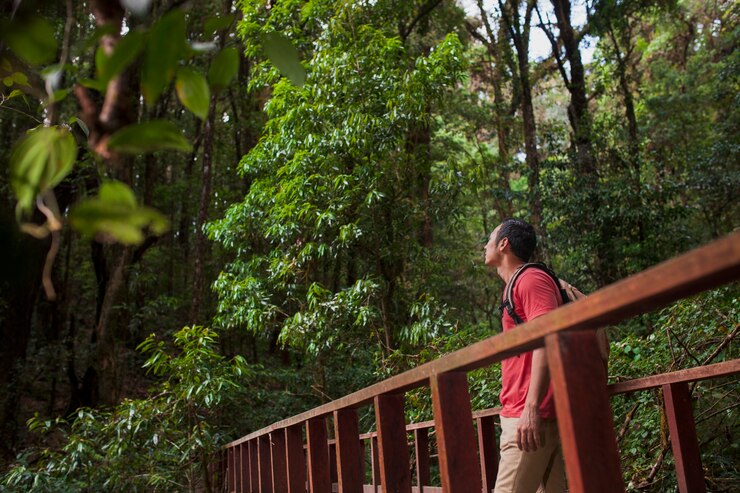Building a Greener Future: The Architectural and Design Principles of Eco Villages
As we strive for a more sustainable future, eco villages which fall under Sundarban eco tourism are emerging as a beacon of hope. These intentional communities prioritize environmental responsibility and social harmony, creating a unique living environment that works in sync with nature. But what exactly makes an eco-village “eco”? This article delves into the architectural and design principles that shape these sustainable communities.

Core Principles Of Living in Harmony with Nature: Sundarban Tourism
The fundamental principle of Sundarban eco tourism under which eco-village architecture plays a huge role. Sundarban forest, its eco-village is dedicated to reducing the negative effects on the environment and promoting a mutually beneficial interaction with the surrounding ecosystem. The following are some fundamental ideas that inform this strategy:
- Sustainable Materials: eco villages prioritize the use of local, sustainable, and recycled building materials. This reduces the environmental footprint associated with the transportation and production of materials. Examples include bamboo, cob (a mixture of clay, sand, straw, and water), and reclaimed wood.
- Energy Efficiency: Building design focuses on maximizing energy efficiency. Through Sundarban eco tourism people have learned about passive solar design principles to utilize natural light and heat, energy-efficient appliances, and renewable energy sources like solar panels and wind turbines.
- Water Conservation: Water conservation is paramount. Practices like rainwater harvesting, greywater systems for irrigation, and low-flow plumbing fixtures are commonly employed to minimize water usage.
- Waste Management: Eco villages prioritize waste reduction, reuse, and recycling. Composting systems, on-site waste treatment, and a focus on reducing single-use items are all part of a comprehensive waste management strategy.

What Are The Components of Design In Eco Villages?
The architectural and design principles of eco villages under the Sundarban forest extend beyond the materials used. Here’s how design fosters a more sustainable lifestyle:
- Smart Land Use: Eco villages of Sundarban eco tourism promote compact living with a focus on mixed-use development. This minimizes sprawl and encourages walkability, reducing reliance on cars. Community gardens and urban agriculture are often integrated into the design, promoting local food production.
- Biomimicry: Drawing inspiration from nature, eco villages may incorporate elements of biomimicry. This can involve using natural ventilation systems or designing buildings that mimic natural shapes for improved energy efficiency.
- Sense of Community: The design fosters a strong sense of community, with shared spaces that encourage interaction and collaboration among residents. This can include community centers, gardens, and courtyards.

Building a Sustainable Future, One Eco-Village at a Time
Eco villages serve as a model for a more sustainable future which helps to promote Sundarban eco tourism even more. By integrating these architectural and design principles, they showcase how communities can live in harmony with nature, reducing their environmental impact and promoting a more mindful way of life. As eco villages continue to evolve and gain traction, they offer valuable insights for architects, designers, and communities seeking to build a greener future for all.
Conclusion
In conclusion, eco-villages that come under Sundarban eco tourism offer a compelling model for building a greener future by integrating architectural and design principles that prioritize ecological sustainability, resource efficiency, and social cohesion. Through sustainable site planning, passive design strategies, sustainable materials, community engagement, regenerative practices, and innovation, eco-villages demonstrate the potential for creating thriving, resilient communities that balance human habitation and nature.
As we face pressing global challenges such as climate change, resource scarcity, and social inequality, eco-villages provide valuable insights and inspiration for a more sustainable and equitable world. By adopting and adapting the principles of eco-village design, we can contribute to a greener future that fosters environmental stewardship, social well-being, and long-term resilience for generations to come.
FAQs
What are the key architectural and design principles of eco villages?
Architectural and design principles of eco villages include passive solar design, use of sustainable and locally sourced materials, energy-efficient building techniques, water conservation measures, incorporation of green spaces and food production areas, and emphasis on community engagement and participation.
How do eco villages contribute to a greener future and environmental sustainability?
Eco villages promote sustainable living practices by integrating renewable energy sources such as solar and wind power, implementing energy-efficient building techniques to reduce energy consumption, conserving water through rainwater harvesting and greywater recycling, and fostering a sense of environmental stewardship and community responsibility.
What are some examples of eco villages around the world that have successfully implemented sustainable design principles?
Examples of eco villages include Findhorn Ecovillage in Scotland, Auroville in India, Dancing Rabbit Ecovillage in the United States, and Crystal Waters in Australia. These communities showcase innovative approaches to sustainable living, including alternative energy systems, eco-friendly construction methods, and organic farming practices.






